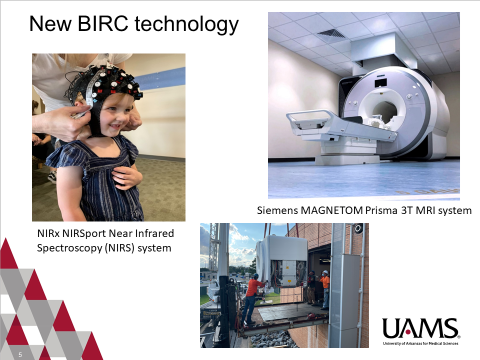Helen L. Porter and James T. Dyke Brain Imaging Research Center (BIRC)
The BIRC is a technology, data science and training center focusing on the brain mechanisms of mental and behavioral health and illness. The central resource is a powerful and multifunctional MRI scanner dedicated to functional and structural human brain mapping.
3 Tesla Siemens Magneton Prisma MRI Scanner
- Visual stimulus projection
- Psychophysiological monitoring
- Response acquisition
- Constant visual and auditory contact with subject
- Wide range of MR imaging sequences to support T1, T2, T2*, diffusion tensor/spectrum imaging, and magnetization transfer imaging
This state-of-the-art, research dedicated MRI system works as a magnentic prism. The Prisma scanner allows for whole brain task-related Functional MRIs to be acquired every 800 ms at 2 mm isotropic resolution with excellent long-term stability, and amenable to the integration of functional and structural brain imaging data. Structural brain images are acquired at very high resolution using distortion-free multiband/multi-shell/multi-shot pulse sequences, which affords greater sensitivity to attempts to map the complex white matter connectivity between specialized brain regions.
New advanced quantitative imaging approaches enable the noninvasive mapping of myelination, a major form of adult brain plasticity. Spectral diffusivity is a flagship of the BIRC’s MRI scanner enabled by the field homogeneity of the Prisma, which is used to resolve multiple water diffusion directions within each voxel, revealing even crossing fibers in deep brain structures.
The BIRC provides multimodal magnetic resonance imaging (MRI) acquisition, processing and analysis approaches to explore the neuroscience of human behavior in healthy and patient populations.
Ongoing Research Focus Areas
- Childhood Adversity and Maltreatment
- Mood instability and affect regulation
- Late life suicidality
- Drug addiction
- Women’s mental health
- Cancer treatment
- Multiple sclerosis
- The neuroscience of individual human variation
- The neural representation of treatment outcome and its prediction
A recent strategic extension of the BIRC is the ongoing creation of a Child Brain Imaging Program (CBIP), Supported in part by funding from the ARA, this new research facility would employ a complementary and wearable functional brain imaging technology to explore the trajectories of brain development in childhood. CBIP’s research focus areas include:
This technology – Near-Infrared Spectroscopy – overcomes the challenges to the use of MRI systems to explore childhood brain development. Functional NIRS (fNIRS) supports hyperscanning or the acquisition of function brain responses simultaneously from two interacting individuals (e.g., a parent and child). The fNIRS technology is also quiet, portable, and allows ongoing behaviors (e.g., meditation).

